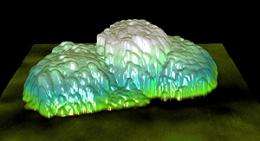Fat gives nanoparticles a fighting chance

(Phys.org) -- Inhalable and thermo-responsive, fat-encased nanoparticles have been developed by researchers at the University of Sydney as possible treatment for lung cancer.
The team has recently designed inhalable, targetable particles that can attack tumours but leave healthy cells undamaged, reducing the side effects of cancer treatment.
The particles consist of a drug encased in a lipid 'fat' that can be activated using a magnetic field.
"When exposed to a magnetic field, the encased super paramagnetic nanoparticles vibrate, melting the fat and releasing the drug," said research leader Dr. Wojciech Chrzanowski and lecturer in pharmaceutics at the Faculty of Pharmacy.
"The system we have developed addresses one of the most important problems related to the side effects of cancer drug therapies, such as undesired interactions with healthy tissues. Since the drug is hidden in a lipid structure until it reaches the target site the healthy cells are protected," says Dr. Chrzanowski.
"We are able to trigger the drug release because our formulation is thermo-sensitive. External stimulus, in our case the electromagnetic field, induces the increase in local temperature within the particles which activates the drug release," he says.
"Under the microscope the external electromagnetic field appears to shake the super paramagnetic nanoparticles in the formulation, producing heat that then breaks open the particles releasing the drug at the tumour site.
"Because the formulation includes superparamagnetic particles we are also able to guide the particles to specific sites using magnets."
Associate Professor Paul Young, newly appointed Head of Respiratory Technology at the Woolcock Institute of Medical Research, says this will provide the opportunity to translate basic bench-particle engineering research into the clinic.
"Our system holds great potential not only as an inhalable formulation but for a wide range of applications where targeting and externally stimulating or triggering drug release is critical.
"The important feature of the system is its ability to 'exploit' the temperature sensitivity of the formulation, so the drug release can be achieved at different temperatures. This is particularly important for multidrug delivery where different active compounds could be released at different times."
The team says another important feature of the drug delivery system is its 'environmentally green' approach which does not use organic solvents, making it easier to manufacture.
Each year lung cancer kills more than one million people worldwide and accounts for more male deaths than any other form of cancer.
Provided by University of Sydney
















